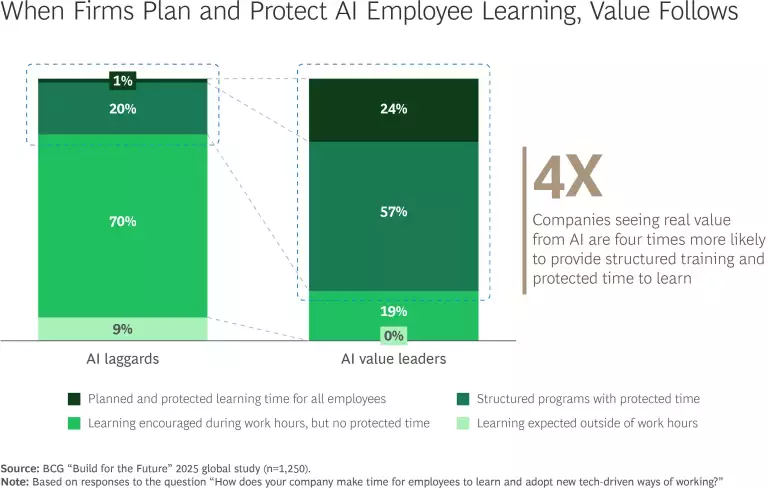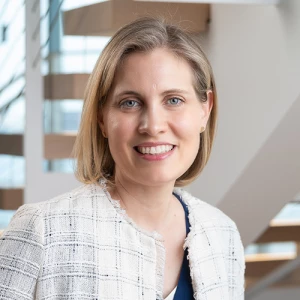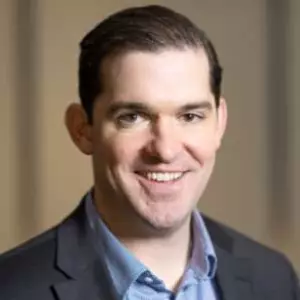To build an AI-first company, CEOs need bold executives who can challenge assumptions, reimagine how the business works, and keep people focused and inspired through relentless change. In the first article of our series on building an AI-first senior leadership team, we examine what CEOs should look for in a chief people officer.
Of all the miscalculations CEOs can make in an AI transformation, underestimating the role their chief people officer (CPO) plays in success is the biggest we’ve encountered.
Over the past two and a half years, in our work with hundreds of companies across industries, we’ve seen CEOs repeatedly cast their CPO (or their chief human resources officer) as a supporting actor—someone who merely implements AI strategy and facilitates workforce transitions—rather than a lead actor who shapes AI strategy from the outset and reinvents critical capabilities.
It’s a costly mistake, one that’s reflected in the widening divide between AI frontrunners and followers.
CEOs need to understand how AI is redefining the chief people officer’s remit—and then determine whether their CPO has the right skill set and mindset to deliver.
Our latest C-suite survey of more than 1,250 companies shows that while nearly every company is experimenting with AI, 60% have yet to generate value from their investments. Of the 40% that are seeing a return, only a small number—the top 5% of companies—are unlocking significant bottom-line value, including 1.7 times greater revenue growth, 3.6 times greater total shareholder return, and 1.6 greater EBIT margin than their lagging peers.
There is still time for lagging companies to close the distance. But they won’t become AI-first organizations just by incubating great tech or recruiting new talent to work with
They’ll also need to earn and maintain the trust of their employees who bring the promise of AI to fruition—people working on the frontlines, in the middle ranks, and deep inside functions that weren’t originally designed with GenAI or AI agents in mind.
All these responsibilities sit squarely within the purview of the CPO, which is why chief executives should give them a starring role in any AI transformation. But to do that with confidence, CEOs need to first gain a deeper understanding of how AI is redefining the CPO’s remit—and then determine whether their CPO has the right skill set and mindset to deliver.
Rethinking the CPO Role
Traditional CPO responsibilities will still be important in an AI-first organization—think talent planning, leadership development, benefits management, performance reviews, and shaping a positive workplace culture. But instead of preserving and incrementally evolving the company, the AI-first CPO will disrupt it by constantly reimagining how work is structured, led, and adapted.
Evidence of this sea change is already visible in how the companies achieving enviable returns from AI—the top 5% that BCG refers to as “future-built” companies—approach upskilling. Compared to laggards, they are four times more likely to have structured AI learning programs and to carve out protected time for employees to learn. (See the exhibit.)

Stay ahead with BCG insights on artificial intelligence
The scope and scale of the challenge companies will face cannot be overstated. Never have CPOs been tasked with upskilling so many workers at once. Large enterprises are looking at entire divisions encompassing tens of thousands of people.
It helps to think of the CPO as a “chief capabilities architect”—a leader who decides what work is best done by people and what is best done by AI, and then builds processes and/or capabilities to redesign workflows that integrate AI tools without breaking worker trust.
That’s a tall order. And it’s one CPOs will face repeatedly as AI opens new frontiers. Major new releases of AI tools will require CPOs to continuously pull jobs apart and reassemble them, deciding not only when to bring in new talent but who to upskill, and how.
This is deep strategic, conceptual work that requires a builder’s mindset and far greater technical fluency than CPOs have needed before. But it also calls for timeless strengths—especially the empathy to guide anxious workers from fear to enthusiasm as AI reshapes their roles.
Is Your CPO AI-First? Five Questions for CEOs to Ask
Though more organizations are scaling AI pilots, the odds of finding a CPO who has led an AI transformation are relatively slim right now. What matters far more at this stage of the AI revolution is whether your CPO—or your candidate for the role—has the right skill set and mindset to shape a strategy that successfully integrates AI into the workforce.
Is my CPO AI-curious? Nearly three years on from ChatGPT’s global debut, your CPO shouldn’t just be talking about AI—they should be using it. At a minimum, that means launching pilots within HR to understand adoption hurdles firsthand and experimenting with ways to overcome them. The CPO will already have started defining KPIs to measure real value creation, like productivity gains, rather than performative engagement.
And while they don’t need to be technical experts, CPOs do need enough hands-on experience and fluency to lead strategy conversations and offer a clear, grounded view of how AI will reshape the workforce.
Has my CPO played a role in another type of transformation? While direct AI transformation experience is still relatively rare, other large-scale change efforts can prepare a CPO to lead the company effectively onto an AI-first footing.
A CPO who helped transition a company through a paradigm-shifting moment—be it a technological transformation or a reimagining of how a particular industry operates—will have some understanding of the magnitude of the task at hand. They will have seen how new technologies redefine roles and workflows. Just as importantly, they’ll have developed the ability to recognize and address the mental, practical, and managerial barriers that can slow or even derail agile transformations.
Can my CPO bring structure to ambiguity? The most successful CPOs we see today combine an innovator’s mindset with a disciplined, structured approach that channels creativity toward the areas of highest value. When they sit at the transformation table, they don’t show up with ten open questions and no answers. They’ve already prioritized three questions they can answer now, three they have strong hypotheses for (with experiments underway to test them), and four that may not need resolution until, say, 2027 but that are being monitored for early signals of acceleration.
Can my CPO create and manage a new social contract with employees? One of the biggest barriers to AI adoption is employee trust—or more precisely, a lack thereof. Employees naturally question whether their jobs will disappear, be downgraded, or lose meaning. It takes tremendous empathy to understand how these very real fears can erode a person’s sense of purpose and entrench resistance to change.
To avoid that outcome, the CPO must draft a new social contract with employees—ideally at the start of the transformation, and with input from workers across the organization—that explains clearly why and how AI will be used, how decisions will be made, and how success will be measured.
Can my CPO claim their rightful seat at the table and challenge me? Too often, the CPO role is treated as secondary, as if their seat at the transformation table has been pushed back a few inches. That won’t cut it. A CPO needs to be comfortable owning the AI talent strategy and having a strong hand in the company’s reinvention. They need to fearlessly challenge assumptions—including from the CEO—about what will and won’t work for the company.
Remember, the CPO needs to lead divisions of workers whose roles have fundamentally changed and guide them continuously forward into the future. They must think and act like a master strategist, a change innovator, and a trust champion.
AI-first companies will be defined not just by their technology, but by how effectively they reshape work and bring their people with them. For CEOs, that means not only ensuring their CPO has a starring role in the AI transformation but is also fully equipped to shine in the role—and to lead your workforce into a very different future.






